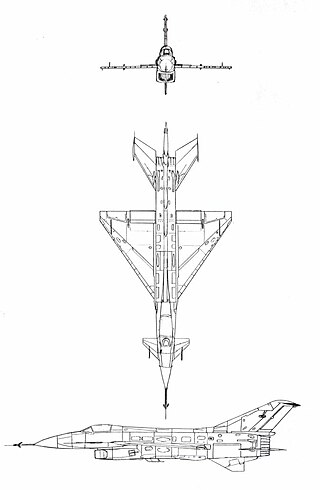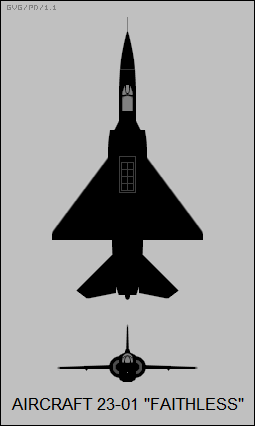
The Mikoyan-Gurevich MiG-9 was the first turbojet fighter developed by Mikoyan-Gurevich in the years immediately after World War II. It used reverse-engineered German BMW 003 engines. Categorized as a first-generation jet fighter, it suffered from persistent problems with engine flameouts when firing its guns at high altitudes due to gun gas ingestion. A number of different armament configurations were tested, but none solved the problem. Several different engines were evaluated, but none were flown as the prototype of the MiG-15 promised superior performance.

The Mikoyan-Gurevich I-270 was a response to a Soviet Air Forces requirement in 1945 for a rocket-powered interceptor aircraft for the point-defence role. In concept and basic configuration, it was related to the early Korolyov RP-318 rocket-powered aircraft which was developed in 1936 and first flew February 20, 1940, and the more recent Bereznyak-Isayev BI-1 Soviet design. Only two prototypes were built, both of which were destroyed in crashes, leading to the cancellation of the project.

The Sukhoi Su-11 was an interceptor aircraft used by the Soviet Union during the Cold War.

The Sukhoi Su-9 was a single-engine, all-weather, missile-armed interceptor aircraft developed by the Soviet Union.

The Sukhoi Su-9 was an early jet fighter built in the Soviet Union shortly after World War II. The design began in 1944 and was intended to use Soviet-designed turbojet engines. The design was heavily influenced by captured German jet fighters and it was subsequently redesigned to use a Soviet copy of a German turbojet. The Su-9 was slower than competing Soviet aircraft and it was cancelled as a result. A modified version with different engines and a revised wing became the Su-11, but this did not enter production either. The Su-13 was a proposal to re-engine the aircraft with Soviet copies of the Rolls-Royce Derwent turbojet as well as to modify it for night fighting, but neither proposal was accepted.

The Tumansky R-15 is an axial flow, single shaft turbojet with an afterburner. Its best known use is on the Mikoyan-Gurevich MiG-25.

Operational Requirement F.155 was a specification issued by the British Ministry of Supply on 15 January 1955 for an interceptor aircraft to defend the United Kingdom from Soviet high-flying nuclear-armed supersonic bombers.
The Sukhoi Su-5 or I-107 was a Soviet mixed-power prototype fighter aircraft built toward the end of World War II.

Yakovlev Yak-50 was an early experimental turbojet interceptor aircraft designed in 1948 by the Yakovlev OKB in the USSR. The aircraft was essentially a stretched version of the Yakovlev Yak-30 (1948), with a more powerful engine and greater wing sweep. The Yak-50 is perhaps most significant as the first Yakovlev aircraft equipped with velosipednoye (bicycle) landing gear, a trademark of later Yakovlev designs. The Yak-50 designation was later reused for a propeller-driven aerobatic and trainer aircraft.
The Shenyang J-13 was a long-running Chinese project by Shenyang Aircraft Corporation to develop a light-weight, single engine fighter aircraft, that was ultimately cancelled.
The Lavochkin La-168 was a jet fighter developed for the USSR. Like the better known Mikoyan MiG-15 which was ultimately selected and went on to become one of the most successful jet fighters of its era, the Lavochkin La-168 was designed in response to a 1946 request for an advanced swept-wing jet fighter capable of transonic performance. It was to use new turbojet based on the Rolls-Royce Nene in competition with the design bureaus of Artem Mikoyan and Mikhail Gurevich, and Aleksandr Yakovlev. A scaled down version of this aircraft would lead to the production of the La-15, which performed well but would be dropped in favor of the MiG-15.

The Mikoyan-Gurevich Ye-8 was a supersonic jet fighter developed in the Soviet Union, intended to replace the MiG-21. Only two prototypes were built in 1960–61. The original MiG-21's air intakes were moved under the fuselage, freeing up the nose where a larger and more powerful radar, able to deliver longer range air-to-air missiles, could be built in. Canards were built to both sides of the nose, in front of the cockpit,.

The Yakovlev Yak-140 was a Soviet prototype lightweight supersonic fighter developed during the 1950s. The prototype was completed in 1954, but it was denied authorization to enter flight testing and the program was cancelled in 1956.
The Mikoyan-Gurevich I-75 was the final design of a series of three experimental swept-wing interceptors developed in the Soviet Union in the mid-late 1950s by the Mikoyan-Gurevich design bureau from their Mikoyan-Gurevich I-3 airframe. All the aircraft in the I-3 program were affected by delays in the development of the Klimov VK-3 turbojet engine, its cancellation and ultimate replacement by the Lyulka AL-7F turbojet engine.
The Tumansky R-21 was a Soviet turbojet engine of the 1960s. Used for development only, the project was canceled.

The Mikoyan-Gurevich Ye-150 family was a series of prototype interceptor aircraft designed and built by the Mikoyan-Gurevich design bureau in the Soviet Union from 1955.
The Mikoyan-Gurevich I-3 was the first of three interrelated fighter prototype programs developed by the Mikoyan-Gurevich design bureau in the Soviet Union in the mid/late 1950s – starting with the I-3, continuing with the I-7 and finally evolving into the I-75. On several occasions airframes were rebuilt and/or reused, both within a program or in a succeeding program. All the aircraft in the I-3 program were affected by delays in the development of the Klimov VK-3 afterburning bypass turbojet engine, and its cancellation and replacement by the Lyulka AL-7F turbojet engine.

The Mikoyan-Gurevich I-320 was a prototype Soviet long-range all-weather interceptor aircraft of the late 1940s-early 1950s. Only two were made, with no production following.
The Mikoyan-Gurevich I-350, was a Soviet Cold War-era experimental fighter aircraft. It was the first Soviet aircraft able to maintain supersonic speed.
The Mikoyan-Gurevich I-7 was a development of the Mikoyan-Gurevich I-3 experimental fighter. Planned as a Mach 2-class aircraft, the I-7 was the second of a series of three experimental fighter aircraft from the Mikoyan-Gurevich design Bureau. Like the Mikoyan-Gurevich I-3, the I-7 was to be one of the components of the automated Uragan-1 then under development by protivovozdushnaya oborona strany, the Soviet defense system.












